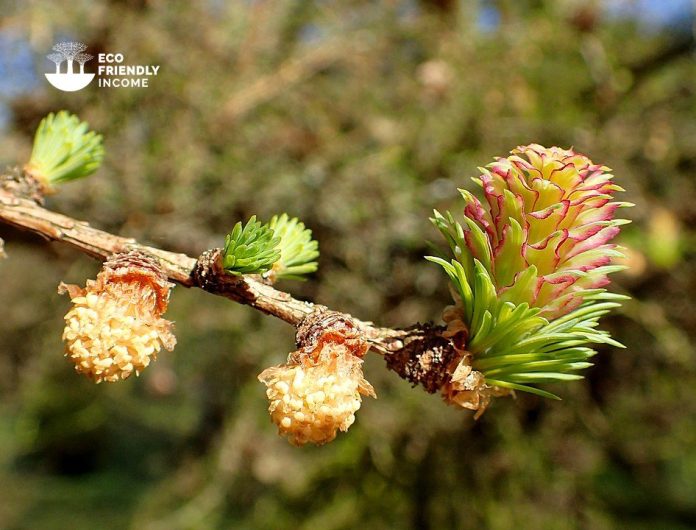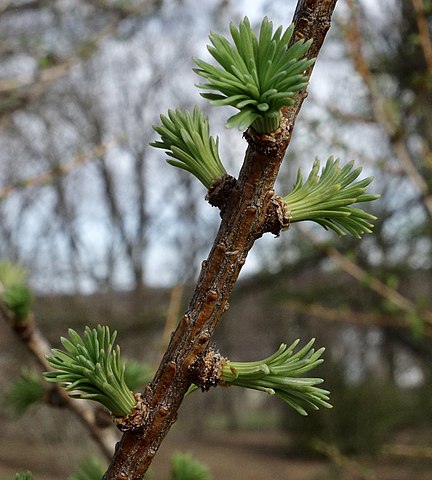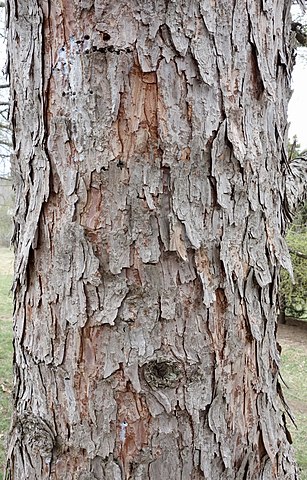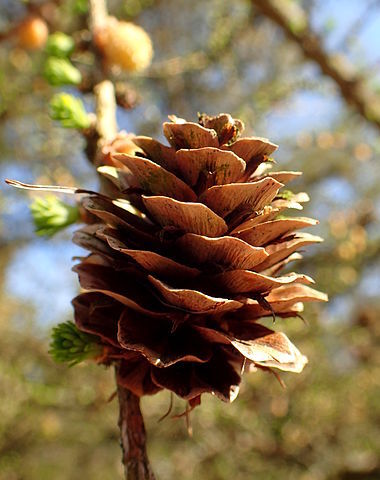
Featured Photo by Krzysztof Ziarnek / CC BY-SA 4.0
A field guide on how to identify and propagate Dahurian Larch (Larix gmelinii), a hardy tree that is native to eastern Siberia.
How to Identify Dahurian Larch (Larix gmelinii)
Leaves

Dahurian larch needles are linear-shaped, with entire margins (smooth). They grow on the stems from fascicle structures in an alternate arrangement.
Bark

The bark of young Dahurian larch trees is smooth and has a red-brown color. As the tree ages, the bark becomes darker and grayer and becomes scaly with longitudinal fissures.
Cones

Pollen cones grow at the ends of branches on short shoots and are yellow.
Seed cones are pointy and green, turning brown and releasing seeds when they are mature. Old cones stay on the tree for a long time and turn gray-black.
Flowering Season
Dahurian larch cones start growing on the trees during summer and become mature for picking in early autumn.
Habitat
The Dahurian larch, also known as Larix gmelinii, is a type of larch tree that originates from eastern Siberia, Mongolia, northeastern China, and North Korea.
Dahurian larch grows in large forests in the Siberian taiga at elevations ranging from 50 to 1,200 meters above sea level.
It can thrive on both moist, boggy soils and well-drained soils, even on shallow soil layers above permafrost.
Some other understory plants that associate with Dahurian larch are:
- Red Currant (Ribes triste)
- Guelder Rose (Viburnum opulus)
Wildlife Value
Mammals: Porcupines feed on the inner bark, snowshoe hares browse on seedlings, and squirrels eat the seeds.
The older larch trees have hollows that serve as a habitat for birds and flying squirrels. Black bears also prefer climbing larch trees for escape due to the tree’s rough bark and large size.
How to Propagate Dahurian Larch (Larix gmelinii)

Hardiness Zone: 0-7

Soil Type: Loam, sand.

Water: Normal to high.

Exposure: Full Sun
You can propagate Dahurian larch with two effective methods:
- Stem Cuttings: It provides established trees faster, but is tricky, and will probably have a lower success rate.
- By Seed: The success rate is high but takes longer to get established saplings.
Sowing seeds is much easier in general than taking stem cuttings.
For that reason, we’ll focus on seed propagation.
Although if you’re interested in stem cuttings, take a look at our propagation guide.
How to Propagate Dahurian Larch (Larix gmelinii) by Seed
If you’re interested in growing Dahurian larch, the best way to do so is by planting seeds.
The best case scenario is if you have access to larch trees nearby, then you can gather the seeds yourself.
If not, you can easily purchase them online at agroforestrysolutions.
Once you have the cones, all you need to do is follow the right steps to extract the seeds.
How to Harvest Seeds
If you want to gather the seeds of the Dahurian Larch tree, the best time to pick the cones is in late summer to fall.
However, it’s even better to wait until mid to late winter when the cones will have been naturally stratified by nature.
Note: In winter, the cones might have already lost most of their seeds to the wind.
To collect the seeds, simply place the cones in a brown bag to dry until they open on their own, then shake the seeds out.
If you can’t wait until winter, you can stratify the cones yourself by following a simple process.
Stratification & Sowing
Want to grow Dahurian larch from seeds? Here’s how you can do it using the cold stratification method:
- Combine the seeds with a mixture of moist sand or peat moss, and put them in a labeled plastic bag with the date.
- Store the bag in the freezer for 21 days.
- After 21 days, remove the bag from the freezer and soak the seeds in warm water for 24 hours to soften their outer layer.
- Keep the seeds in the refrigerator for another 7 days, making sure the sand or peat moss stays moist.
- Once the stratification period is over, plant the seeds in a well-draining soil mix of peat moss and sand. Keep the soil moist until the seeds germinate.
With these simple steps, you’ll have your larch seeds germinating in no time (about a week)!
FAQ
Q: What’s unique about the Dahurian larch?
A: It’s the northernmost tree in the world, it even grows in creeping form in the tundras of Russia’s Taymir Peninsula.
Q: Is Dahurian larch cold hardy?
A: It’s actually the most cold hardy tree in the world, it’s been recorded to tolerate temperatures as low as -70 Celcius in the Oymyakon–Verkhoyansk region of Yakutia, Russia.
Q: What’s the oldest Dahurian larch tree recorded?
A: One tree in Yakutia was recorded as being 919 years old.
Q: Does Dahurian larch need cold stratification?
A: Yes, for higher success, a 30-day cold stratification period is required.
